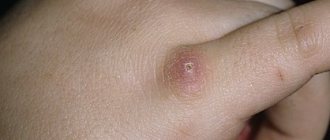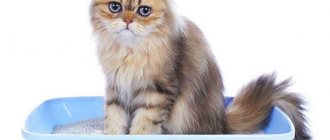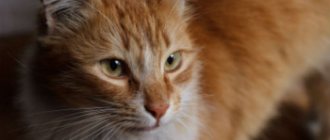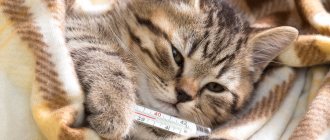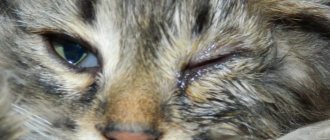Little lumps coming into the world are not only joy, but also a colossal responsibility. For newborn organisms, there are many dangers in the world where they come. Babies can get some diseases in the womb, others are transmitted with milk, and some lie in wait in the first weeks of life. Each disease must be carefully examined and measures taken, since a fragile kitten is unlikely to be able to cope with sometimes quite formidable diseases on its own.
Fading kitten
This pathology develops in the womb.
Causes:
- Placental abruption.
- Wrong choice of paternal line.
- Infectious, viral diseases during pregnancy.
- Incorrectly formulated diet for pregnant and lactating pussy.
Children exhibit the following symptoms:
- Underweight (weight 25% lower than healthy members of one litter).
- Dehydration.
- Lack of physical activity.
- Hypothermia.
Unfortunately, the disease cannot be treated, and the sick pet is doomed. To prevent this situation from happening, you need to take preventive measures even before the kittens appear:
- Follow the expectant mother's vaccination plan.
- Provide the pregnant animal with adequate nutrition.
- Take a responsible approach to choosing the breeding half.
- Maintain good care.
Toxic milk syndrome
This pathology is observed in newborn pets whose mother is sick (metritis or septic mastitis in the acute stage). Manifestations of milk intoxication:
- Pets refuse to suck and squeak loudly.
- The cubs' bellies are inflated.
- Loose stools come out.
- Rapid loss of water in the body begins.
- The anus is inflamed.
- Blood poisoning begins.
For successful treatment, the litter is weaned from breastfeeding and switched to artificial food. Smecta relieves symptoms of diarrhea and bloating.
For prevention, it is necessary to monitor the condition of the nipples and milk in a nursing cat.
Hypogalactia
Such a tricky name hides a very simple reason - lack of lactation in a nursing mother. Milk deficiency leads to malnutrition and malnutrition in babies.
Causes of hypogalactia:
- The cat is primiparous.
- The nursing animal has poor nutrition.
- The litter is too numerous.
To get rid of the problem, you need to provide the mother with a nutritious diet, rich in protein and carbohydrate foods, and supplement the kittens with artificial feeding. At one month of age, you can start introducing complementary foods.
Hypothermia
From the name it is already clear what the cause of the pathology is. In the absence of a cat and the babies being warmed with their warmth, they lose their body temperature, which drops to 35.6C. This is very little. The cubs freeze and stop moving. The same consequences will occur at low temperatures in the room where the children are.
To bring a cat baby back to life, you need to warm it up gradually, covering it in layers. Pour glucose (5-10%) into the mouth. Be sure to seek help from a doctor. To prevent such situations from happening again, pay careful attention to insulating the cat’s nest.
Treatment
For the treatment of uncomplicated felinosis, erythromycin 500 mg 4 times a day, doxycycline 100 mg 2 times a day or ciprofloxacin 500 mg 2 times a day are used. The course of treatment is 10-14 days. Alternative drugs are tetracyclines, azithromycin, chloramphenicol, ofloxacin in medium therapeutic doses. The effectiveness of these drugs is not always evident. Symptomatic medications, vitamins, and antihistamines are prescribed. Nonsteroidal anti-inflammatory drugs (indomethacin, voltaren, etc.) are indicated. When a lymph node softens, an incision or puncture is made to remove pus.
Anemia
Kittens suffer from anemia in cases where the mother suffers from it or they are infected with a helminthic infestation.
Signs of anemia in babies:
- Poor development, retardation.
- Pale mucous membranes.
To get rid of the problem, you will have to introduce iron-containing food and vitamins into your diet. To prevent anemia, it is necessary to promptly carry out antiparasitic measures in a pregnant animal and provide adequate feeding.
Differential diagnosis
The disease should be distinguished from tularemia, plague, infectious mononucleosis, lymphomas of various etiologies and other diseases accompanied by lymphadenopathy. Felinosis is characterized by the formation of a primary affect followed by the development of intoxication syndrome and regional lymphadenitis, most often with an enlargement of one lymph node without the phenomena of periadenitis. Epidemiological history data are of great importance: contact with cats, scratches, bites or salivation.
Dehydration
In other words, dehydration. It occurs not only against the background of any disease, but also as an independent phenomenon when a small pet is not able to reach breast milk.
Signs of manifestation:
- Dryness of the oral mucous membranes.
- Weak muscle tone.
- Bright red color of the baby's mouth and tongue.
Dehydration can only be treated with veterinary prescriptions. Artificial complementary feeding is used as a preventive measure.
Hemolysis
This is the name for blood incompatibility between a cat and its cubs, in which erythrocyte breakdown occurs in the blood of newborns.
Manifestation of the disease:
- Yellow mucous membranes.
- Reluctance to breastfeed.
- Lethargy.
- Brown color of urine.
- Death of tail tissue (at the end).
No treatment has yet been found for this disease, which means the baby is doomed to death. For preventive measures, blood type diagnostics and brown urine testing are used. Once the diagnosis is confirmed, babies are weaned and artificially fed.
Dermatomycoses
Dermatomycoses are infectious zooanthroponotic diseases with characteristic lesions of the skin and its derivatives, caused by pathogenic dermatophyte fungi.
Among animals, the most common are: trichophytosis, microsporia, scab.
Microsporia and trichophytosis are combined under one common name “ringworm”.
Symptoms:
- With microsporia - the appearance of limited spots of peeling and the formation of crusts on the skin of the paws, muzzle, and torso. The hair in the affected areas is sparse and breaks off easily. Lesions can be focal or disseminated.
- In cases of trichophytosis, sharply limited foci with broken hair and a flaky scaly surface or areas of inflamed skin and its follicles form on the skin in the area of the head, neck, torso, base of the tail and limbs.
Treatment:
1. When choosing medications, special increased skin sensitivity should be taken into account, and therefore it is necessary to give preference to products that have minimal irritating and cauterizing effects: Vaganova ointment (Lysol - 30.0; birch tar - 50.0; sulfur color and ASD, fraction 3—100.0 each; petroleum jelly—800.0), SK-9—chlorinated turpentine (200–500 ml per 10 liters of water), ROSC preparation, trichocetine (in the form of 2% liniment), phenothiazine (5% fish oil solution).
2. For disseminated lesions, the use of the antibiotic griseofulvin is indicated. It is prescribed orally at a dose of 2 mg per 1 kg of animal weight for 8-15 days.
============================================================================================================================================================================================
Umbilical inflammation
This problem occurs when the umbilical cord is not processed correctly:
- Its remainder is too short or, on the contrary, long.
- The kitten is in unsanitary conditions.
- The cat has problems with her teeth and oral cavity.
A sick kitten's navel is swollen, inflamed and red. Purulent discharge oozes from it. To prevent the development of this situation, you need to properly cut and treat the umbilical cord at birth with antiseptics.
Demodicosis
Demodicosis is a skin disease in cats caused by the demodex mite.
Symptoms:
- Severe itching
- Focal hair loss with the formation of scales and crusts in areas of baldness. Demodicosis usually affects the head, ears and neck of cats.
- Generalized demodicosis can lead to widespread areas of hair thinning and baldness, and fluid-filled ulcers may form on the skin.
- Cats may begin to lick and groom their fur excessively, which leads to even more severe hair loss.
Treatment:
1. Bathing with anti-scabies shampoo. Bathing can be continued for 4 to 6 weeks to kill all mites as the shampoo does not affect their eggs. Treatment should continue until tests come back negative.
2. The drug amitraz can also be used, but it is toxic to cats and often leads to poisoning, so it must be used with extreme caution.
3. Take ivermectin daily or weekly for four weeks, however this is also not intended for cats and has a high risk of side effects.
============================================================================================================================================================================================
Viral pneumonia
A dangerous disease for fragile small organisms. It occurs as a result of viral infections suffered during illness and lack of vaccinations.
Manifestations of the disease in kittens:
- The animal meows pitifully, does not eat breast milk, and refuses to attach to the nipple.
- Body temperature rises.
- Coughing and sneezing begins.
- Mucus is discharged from the nose.
- The oral cavity becomes covered with ulcers.
- Conjunctivitis and lacrimation develop.
Immediate seeking of professional medical help is required. To prevent the occurrence of viral pneumonia, you need to follow the vaccination schedule, exclude contact of the animal with other pets and people, and monitor the cleanliness and temperature of the room.
Description of diseases with symptoms and prevention
Cat diseases are classified according to the place of occurrence and causes of infection. Most often they affect the skin, organs of vision and hearing, teeth, genitourinary system, gastrointestinal tract, cardiovascular and musculoskeletal systems. The risk group includes unvaccinated and uncastrated animals. They are especially vulnerable to infectious and oncological pathologies.
Viruses and infections
Infectious diseases in cats are caused by single-celled microorganisms: viruses, bacteria and fungi. The most dangerous are pathologies of viral etiology. They constantly mutate and retain their pathogenic properties for a long time, even in the external environment.
Panleukopenia (distemper)
Panleukopenia is transmitted through direct contact with an infected person and his biological fluids (urine, saliva). It is easily transferred to clothing and shoes, so the only effective method of prevention is vaccination. Lack of vaccination increases the risk of complications and death. When infected, the following are observed:
- fever;
- weakness and apathy;
- loss of appetite;
- foamy yellow or green vomit;
- foul diarrhea;
- the appearance of skin inflammations, gradually filling with purulent contents.
Distemper is especially dangerous in kittens - without urgent treatment, the probability of death tends to one hundred percent.
Calcivirosis
Animals become infected through nutrition (contact with an infected person) or aerogenously (care items, clothing). To protect against calcivirus, mandatory vaccination is recommended for up to a year. Infected people develop:
- fever;
- leakage of serous fluid from the eyes and sinuses;
- profuse drooling;
- swelling and ulcers on the skin.
In kittens, calcivirosis progresses rapidly, so immediately after detecting suspicious symptoms, you need to take the baby to a veterinarian.
Rhinotracheitis
The virus spreads in a similar way to plague and calcivirus. The risk of infection is reduced by complex vaccination at 2-3 months, and then by annual vaccination. When infected it is noted:
- lethargy and loss of appetite;
- increased body temperature;
- runny nose with discharge of serous or purulent fluid;
- cough and shortness of breath;
- ulcer of the cornea and tongue.
In terms of symptoms, rhinotracheitis is similar to chlamydia, but it is not dangerous for people and other pets.
Salmonellosis
The pathogen enters the body along with fish or meat that has not undergone heat treatment. Its symptoms are similar to feline distemper, but are easier to treat. These include:
- lethargy;
- a sharp increase in temperature;
- frequent vomiting and diarrhea interspersed with blood;
- profuse drooling;
- convulsions;
- discharge of pus from the sinuses.
Advanced salmonellosis leads to bronchopneumonia and is especially dangerous for kittens.
Trichophytosis (ringworm)
The risk of fungal infection occurs with low immunity. Ringworm is contagious to all mammals, including humans, and treatment lasts at least 1 month. After the first symptoms of this disease are detected, the cat is diagnosed and treatment begins. You should contact your veterinarian if:
- severe itching;
- peeling and inflammation;
- hair loss;
- pigmentation changes.
For preventive purposes, vaccination is acceptable, but it is less effective than vaccination against panleukopenia. Regular cleaning of the premises, timely administration of anthelmintics, high-quality nutrition and preventive examinations by a veterinarian will help to avoid infection.
Parasitic infections (helminthiasis, flea and tick infestations)
Parasitoses are placed in a separate group. They are accompanied by itching, partial baldness and bowel dysfunction. To protect against parasites, it is recommended to carry out regular antiparasitic treatment and avoid contact with unfamiliar animals.
Skin problems
Skin problems not related to body trauma are caused in two ways: infectious and allergic. Each of them requires specific treatment.
Infestation with scabies mites (otodectosis, demodicosis, sarcoptic mange, notoedrosis)
Parasites are transmitted through direct contact with an infected person or with his personal belongings. An exception is the demodex canis mite, which causes demodicosis. It lives in the body from birth, but becomes pathogenic only with a sharp drop in immunity. If a cat is sick, then soon its entire body will be covered with scabies. When infected, the following appears:
- constant itching;
- excessive hair loss, leading to the formation of bald spots and bald spots;
- inflammation of the lymph nodes;
- nodular rash filled with thick fluid;
- severe pain at the site of redness and suppuration.
Unlike humans, for whom scabies mites are not life-threatening, cats can die. This happens in advanced cases when parasites have penetrated into the internal organs.
Allergy
Most often, pets experience atopic dermatitis (an allergy to pollen and other environmental components) and an allergic reaction to flea bites. Food allergies are also common, especially in albinos or sensitive breeds. This is an individual reaction of the body to certain irritants, so it is difficult to avoid it with preventive measures. Allergy attacks are suppressed with glucocorticoids and antihistamines. They appear:
- itching;
- small rash;
- partial baldness and dandruff formation;
- the appearance of granulomas and ulcers on the body.
The danger of skin diseases in cats is the high probability of secondary infection. Open wounds attract pathogenic microorganisms, so it is important to eliminate them first.
Pathologies of the oral cavity
With insufficient oral hygiene or eating only soft foods, tartar forms on the teeth. Due to the accumulation of plaque, the surface of the tooth is damaged. Bacteria penetrate into it, damaging the enamel and gums. A sick pet develops caries or periodontitis. Older animals have a poor prognosis and often require removal of damaged teeth.
Gum damage is accompanied by:
- low appetite;
- unpleasant odor from the mouth;
- profuse salivation;
- the formation of yellow-brown deposits on the enamel;
- redness and inflammation of the gums.
For preventive purposes, it is recommended to regularly clean your mouth. It is also important to combine dry and wet feeding. Hard pieces of dry food clean the surface of the tooth, and soft food relieves stress on the gums.
Eye and ear diseases
Ophthalmological diseases in cats are very dangerous and can lead to loss of vision. The most common:
- Conjunctivitis
. The main causes of damage to the mucous membrane of the eye are mechanical injuries, chemical poisoning, bacterial infection and allergies.
- Blepharitis
. Damage to the cornea is caused by parasites or internal disorders (problems with hormones, sebaceous glands or autoimmune diseases).
The symptoms of these pathologies are similar and include:
- redness and swelling of the mucous membrane;
- increased lacrimation and swelling of the eyelids;
- difficulty opening eyes.
Regular eye examinations and the use of Diamond Eyes drops, which have an antibacterial effect, will help you avoid unpleasant consequences.
Ear care is also important, which involves weekly cleansing of accumulated plaque. Otherwise, otitis may occur, accompanied by:
- change in behavior (lethargy, anxiety and aggression);
- shaking the head due to itching;
- formation of redness and brown discharge in the ear.
Similar symptoms occur with otodectosis - infection with ear mites. Without timely treatment, hearing loss may occur. The risk group includes kittens and older individuals.
Diseases of the genitourinary system
Urolithiasis in cats occurs due to feeding with low-quality food, as well as low activity and excessive body weight. Its symptoms include:
- difficulty urinating;
- the appearance of blood in the urine;
- severe pain;
- restless behavior and refusal to eat.
In advanced cases, the bladder may rupture, which can be fatal for the pet. A balanced diet, weight control and regular physical activity will help avoid the development of urolithiasis.
Gastrointestinal disorders
Gastrointestinal upset is always accompanied by vomiting, diarrhea or constipation. More pronounced symptoms depend on the specific type of pathology:
- Diabetes
. Accompanied by increased thirst and frequent urination. In a complicated form, it is fraught with coma, which can be stabilized. The disease is typical for cats with a sedentary lifestyle that have not been castrated.
- Gastritis
. Accompanied by the appearance of a white coating on the tongue and an unpleasant odor from the mouth. It often becomes chronic and is associated with poor quality feeding.
For prevention purposes, monitor the amount of food you eat and avoid overeating. Play with your pet regularly and monitor its weight.
Cardiovascular pathologies
Every tenth cat is diagnosed with hypertrophic cardiomyopathy. It is accompanied by rapid heartbeat and fainting. Other symptoms (lethargy, rapid fatigue) are hardly noticeable, so treatment is not always provided in a timely manner. This disease in cats is genetic and cannot be prevented. The only way to avoid complications is to regularly visit the veterinarian. The sooner the problem is diagnosed, the less likely the consequences.
Other cardiac pathologies (for example, heart attack) are very rare in cats.
Oncology
At an early stage, oncology is difficult to diagnose due to vague symptoms. Common diseases include:
- sarcoma;
- carcinoma;
- lymphoma.
The patient's appetite decreases, bowel dysfunction occurs, and body weight decreases sharply. Malignant neoplasms appear on the body: spots, bumps, swellings, ulcers. When palpated, they cause pain and can grow on neighboring tissues.
Unvaccinated and uncastrated animals are more vulnerable to cancer. For prevention purposes, it is recommended to sterilize your pet before the first heat, and neuter the cat before the age of one year.
Musculoskeletal disorders
Problems with the musculoskeletal system reduce activity. In advanced cases, they develop into a chronic form. Most often diagnosed:
- Arthritis
. Occurs due to obesity or injury. Swellings that appear in the joint area are accompanied by pain when palpated.
- Arthrosis
. Develops with excessive physical exertion and low amounts of phosphorus and calcium. Leads to lameness, crunching in the joints and their deformation.
Both arthritis and arthrosis have similar symptoms. Only a veterinarian can determine the type of violation - after diagnosis, treatment will be prescribed and the basics of caring for a sick animal will be prescribed.
To prevent possible complications, keep your diet balanced. When feeding naturally, be sure to add vitamins to the food, approved by your veterinarian.
Conjunctivitis
Disease of the mucous membranes of the organs of vision occurs in kittens in cases where the mother has had a viral infection, the babies' eyes have been damaged and scratched even before they opened.
Manifestation:
- Purulent leakage from under the eyelids when closed.
- Formation of crusts on the eyelids.
- Redness and swelling of the eyelids.
Boric acid is used to treat conjunctivitis. The kittens' eyes are washed with a 2% solution. Plus, antibacterial eye medications are dripped.
How to tell if your cat is not okay
The prognosis for the treatment of cat diseases depends on the symptoms and the time of their detection. Changes in the pet’s usual state are:
1. Behavioral.
If an active and always hungry cat spends the entire day on the couch, avoids communication and refuses his favorite food, sound the alarm. Reverse changes are no less dangerous. Excessive activity and increased appetite, which are not characteristic of an animal, are a sign of a malfunction within the body.
2. Physiological.
This group includes more obvious violations that are understandable not only to the owner, but also to an outsider:
- intestinal disorder (diarrhea, constipation);
- difficulty urinating;
- nausea and vomiting;
- the appearance of redness and peeling on the skin;
- hair loss;
- loss of coordination;
- increase or decrease in normal temperature;
- increased or slow heart rate;
- excessive discharge from the eyes, nose or ears.
Of particular danger is the appearance of blood in stool or vomit. This symptom always accompanies internal injuries and requires urgent assistance from a veterinarian.
Neonatal infectious peritonitis
Peritonitis of an infectious nature occurs in the absence of necessary vaccinations in a pregnant cat, infectious diseases suffered during the period of waiting for kittens, or weakness of the immune system of the newborn.
Symptoms:
- Cyanosis.
- Labored breathing.
- Exhaustion.
- Weakness.
- Fading.
Unfortunately, this pathology is also not curable. A sick animal must be isolated from the rest of the litter to avoid transmission of infection. For prevention, vaccination measures, limiting contact with other animals and humans, maintaining temperature and sterile conditions are extremely important.
Breeds that are more susceptible to peritonitis than others:
- Burmese cat.
- Persian.
- Abyssin.
- Rex.
- Redgoal.
- Bengal.
Age-related diseases of cats
In older cats, most diseases are associated with a gradual decline in immunity. Due to disruptions in the immune system, the following develops:
- diabetes;
- renal and liver failure;
- hypertrophic cardiomyopathy;
- thyroid diseases;
- arthritis;
- inflammation of the gums
There are other ailments that are dangerous for old cats, but the ones listed are the most common. If the pet has not given birth and has not been sterilized, then there is a high risk of developing malignant tumors on the mammary glands or pyometra (uterine abscess). Their removal often requires surgery performed under general anesthesia. It is difficult to tolerate in old age, so be sure to sterilize non-breeding animals immediately after puberty.
Pay special attention to nutrition - the veterinarian will tell you which diet is suitable for an older pet. Ideally, your cat should be examined by a veterinarian every six months after reaching 10 years of age. This will include an examination and blood sampling.
